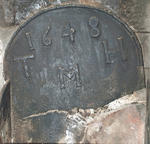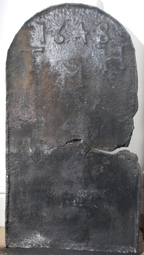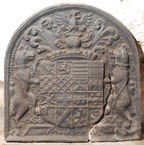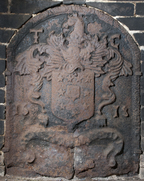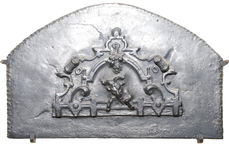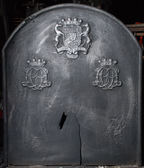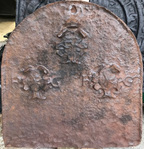-
975
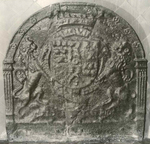 ? x ? mmImage subject to copyright
? x ? mmImage subject to copyrightDescription: Arched shape; double-fillet edged arched border, with six evenly-spaced roses, resting on pilasters; shield, supporters, garter and coronet of the Earl of Exeter; plain rectangular bottom panel.
Notes: The arms are of the earldom of Exeter, which was created in 1605 for Thomas Cecil, 2nd Lord Burghley (1542-1623).
Inscription: HONY SOIT QVI MAL Y PENSE [illegible]
Arms: Cecil, Earls of Exeter
- Decoration tags:
- rounded arched (shape)
- fillet (edging)
- whole carved pattern
- armorial
Manufactured: in the early-17th century in Wales.
Current location: Plas Llanmihangel, Llanmihangel, Glamorgan, Wales.
Museum number: GL 7628 (part of the National Monuments Record of Wales museum group)
- Attached to series:
- Personal armorial firebacks
-
1074
Description: Arched; twisted rope edging; date at top; initials in triad below date.
Notes: A tall fireback in proportion to its height, probably specifically related to its early use with a coal fire.
Inscription: 1648 / TMH [triad]
- Decoration tags:
- rounded arched (shape)
- rope (edging)
- carved stamps
- individual letters
- individual numbers
- text
Manufactured: in 1648 possibly at Tintern Furnace in the Forest of Dean area of Wales.
Current location: in private hands, Mathern, Monmouthshire, Wales.
- Attached to series:
- 1640-50s Dean series
-
1073
Description: Arched; twisted rope edging; date at top; initials in triad below date.
Notes: An unusually tall fireback in proportion to its height, probably specifically related to its early use with a coal fire.
Inscription: 1648 / TMH [triad]
- Decoration tags:
- rounded arched (shape)
- rope (edging)
- carved stamps
- individual letters
- individual numbers
- text
Manufactured: in 1648 possibly at Tintern Furnace in the Forest of Dean area of Wales.
Current location: in private hands, Mathern, Monmouthshire, Wales.
- Attached to series:
- 1640-50s Dean series
-
823
Description: Arched shape with ovolo egg-and-dart edging; crown surmounting a shield, a quartered shield with an escutcheon impaling a crowned lion rampant with an escutcheon; text along the bottom.
Notes: The arms have not been identified; LOVEN is the town of Leuven, capital of the province of Brabant, which, in 1662, was in the Spanish Netherlands.
Inscription: LOVEN 1662
- Decoration tags:
- rounded arched (shape)
- ovolo, egg and dart (edging)
- carved pattern panels
- armorial
- text
- plants
Manufactured: in 1662 possibly in the Ardennes area of Belgium.
Current location: in private hands, Mayfield, East Sussex, England.
- Attached to series:
- Foreign armorial firebacks
-
498
Description: Arched plate; ovolo moulding edging; shield, supporters, coronet, helm, crest and motto of Viscount Montague; quarterly Browne, Albini, Fitzalan, Fitzalan of Clare, Warren, Maltravers, Nevill, Montagu, Monthermer, Inglethorpe, Burghe, Delapole, Bradeston, Tiptoft, Charleton and Kent (Plantagenet); supporters: two bears collared and chained; the crest: an eagle, the wings elevated and displayed.
Notes: The arms of either the 2nd (Anthony-Maria Browne, succ. 1592-1629) or 3rd viscount (Francis Browne succ. 1629-1682) - the 1st viscount was a Knight of the Garter and no garter is shown; the style of the modelling bears similarities to that on the 1618 series of firebacks and may be the work of the same pattern-maker.
Inscription: 16 / VERITATE DUCE [Be led by Truth]
Arms: Viscount Montague
- Decoration tags:
- rounded arched (shape)
- ovolo (edging)
- whole carved pattern
- armorial
- text
Manufactured: in the late-16th to early-17th century in England.
Current location: Cowdray House ruins, Midhurst, West Sussex, England.
Citation: Dawson, C., 1903, 'Sussex Iron Work and Pottery', Sussex Archaeological Collections, 46, pp. 1-54.
Citation: Gardner, J. S., 1898, 'Iron Casting in the Weald', Archaeologia, 56, 1, pp. 133-164.
- Attached to series:
- Cowdray firebacks
- Personal armorial firebacks
-
954
Description: Arched shape; patterned astragal edging; central shield with helm, crest and mantling above, and motto scroll below; initials either side of crest; date split by shield.
Notes: The arms are those of Chamberlayne: gules, an inescutcheon within an orle of mullets argent; the crest: out of a ducal coronet the head of an ass (the tinctures vary according to the branch of the family); the initials are reputed to be those of Thomas Chamberlayne; the date appears to have been hand inscribed. The style of the carving is the same as on two other firebacks in the same county.
Inscription: T C / 16 18 / [motto unreadable]
Arms: Chamberlayne
- Decoration tags:
- rounded arched (shape)
- astragal (edging)
- whole carved pattern
- individual letters
- individual numbers
- armorial
- text
Manufactured: in 1618 possibly in the Herefordshire area of England.
Current location: Hellens Manor, Much Marcle, Herefordshire, England.
- Attached to series:
- Personal armorial firebacks
- Herefordshire armorial series
-
559
Description: Arched rectangle with crude scalloping around the edges; elaborate, symmetrical strapwork frame with scrolls top left and right, and below, a bunch of grapes hanging from the top, and the head and forelegs of a goat climbing through; inside each upper scroll, a small astragel edged oval.
Notes: This strap-work stamp, characteristic of late-16th and early-17th century architectural drawings and engravings and derivative of the work of artists like Hans Vredeman de Vries, was probably derived from interior carving on a fireplace overmantel or similar. The goat and bunch of grapes suggest an allusion to Bacchus. Marks round the edge of this fireback suggest that it may have been reduced from a larger size. Mitford collection, Petworth House.
- Decoration tags:
- rounded arched (shape)
- scalloped (edging)
- simple stamps
- architectural
- animals
- plants
- objects
Manufactured: in the late-16th to early-17th century possibly in the Weald area of England.
Current location: Petworth House, Petworth, West Sussex, England.
Museum number: NT/PET/M/53 (part of the National Trust museum group)
- Attached to series:
- Miscellaneous stamp firebacks
-
582
Description: Arched shape with ovolo-moulded edging; figure of a classical warrior with plumed helmet and shield, holding a sword in his right hand; inscription to left of head, probably continued to right by now no longer visible.
Notes: An unusually striking fireback of simple design. Mitford collection, Petworth House.
Inscription: ANNO ...
- Decoration tags:
- rounded arched (shape)
- ovolo (edging)
- whole carved pattern
- pictorial
- mythological
- text
- humans
Manufactured: in the mid- to late-17th century possibly in the Lorraine area of Germany.
Current location: Petworth House, Petworth, West Sussex, England.
Museum number: NT/PET/M/73 (part of the National Trust museum group)
- Attached to series:
- Miscellaneous pattern firebacks
- 'Dutch' Miscellaneous Firebacks
-
641
Description: Rectangular with arched top; astragal moulded edging (top and sides); top centre, shield, supporters, coronet and motto of the 1st Baron Ashburnham: (1st & 4th) gu. a fess between six mullets ar. (Ashburnham), (2nd) az. semee of fleurs-de-lys a lion rampant guardant ar. (Holland), (3rd) erm. three crescents gu. (Kenn); on an escutcheon of pretence, sa. a chevron between three boys' heads couped at the shoulders proper each entwined around the neck with a snake vert (Vaughan). Supporters: two greyhounds sa. their faces, breasts, and feet ar. collared and lined or; below left and right, a monogram of B and J with a baron’s coronet above.
Notes: John Ashburnham, who married Bridget Vaughan in 1677, was created baron in 1689. he died in 1710. The fireback dates from between 1689 and 1710.
Inscription: LE ROY ET L’ESTAT
Arms: John, 1st Baron Ashburnham
- Decoration tags:
- rounded arched (shape)
- astragal (edging)
- carved stamps
- armorial
- text
Manufactured: in the late-17th to early-18th century probably at Ashburnham Furnace in the Weald area of England.
Current location: Mark Ripley Forge & Fireplaces, Northbridge Street, Robertsbridge, East Sussex, England.
- Attached to series:
- Ashburnham family firebacks
- Personal armorial firebacks
-
1306
Description: Arch shaped; rope edging (top and sides); top centre, crowned cartouche with initials F S linked with twisted cord; below, two cartouches, each bearing a 7-pointed star, and each separating the paired initials HG.
Notes: The national origin of this fireback is a little uncertain. A variant of this fireback (no. 767) has slightly different proportions and relative positions of the stamps.
Inscription: F S / H G H G
- Decoration tags:
- rounded arched (shape)
- rope (edging)
- carved stamps
- heraldic
- text
Manufactured: in the 16th century possibly in the Lorraine area of France.
Current location: Ripley Forge & Fireplaces, Northbridge Street, Robertsbridge, Salehurst, East Sussex, England.
- Attached to series:
- Miscellaneous stamp firebacks
- Cord-linked initials firebacks
